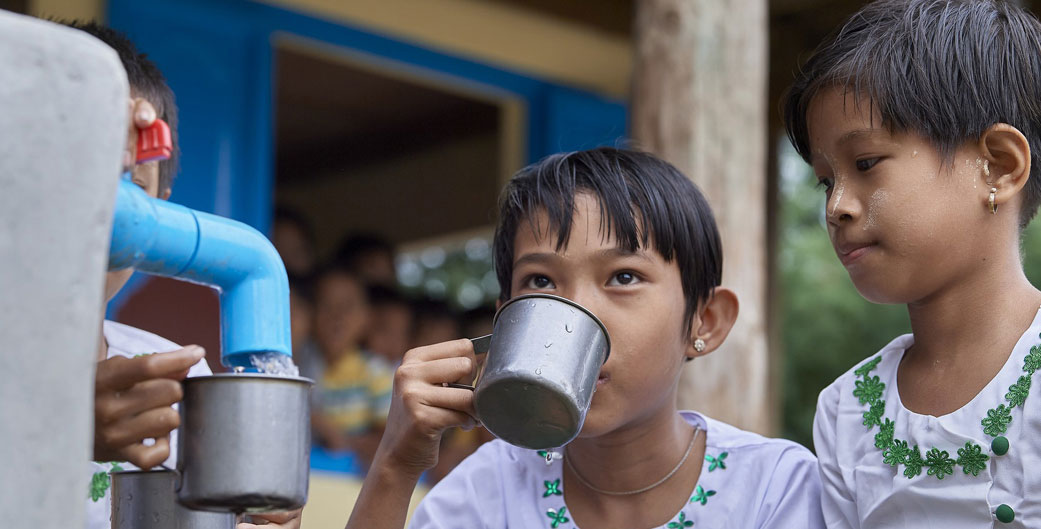How clean water came to be in Myingyan
Choose the language in Burmese
The Ayeyarwady is more than a great river. It is Myanmar's vein of life. For villagers who live near its banks it is the provider of their livelihoods and the supplier of sustenance. But the flowing waters that pass near their homes are not for drinking. Nor are the ponds and rivulets that form and gather nearby risk-free. Villagers rely on drinking water from underground.
Nestling a thirty-minute walk beyond the Ayeyarwady's riverbanks among the trees and paddy fields west of Myingyan in the Mandalay region, Aye village is typical of small communities in the Myingyan region. A farming community residing in a cluster of mostly traditional bamboo and wood houses, its water supply had long consisted of a government-cut river canal that channelled water from the Ayeyarwady to irrigate the farmland and, for the villagers' household needs, a simple tube pipe for drawing water for drinking and cooking.
Through a simple piece of tubing plunged down through the earth, the villagers drew their water by hand-pumping the brown-tinged water to the surface. Muddy particles in the water were removed by a cloth sieve. Against smaller particles there was no defence.
Aye's villagers were used to this liquid as their only source of drinking water and most of the time suffered no worse ill-effects than having to swallow water that had a muddy after-taste. But they daily risked far worse consequences.
The reality for millions of rural Myanmar people dependent upon inadequately-filtered water from basic tube wells is the possible debilitations brought by waterborne diseases. Diarrhoea is but the most immediate result. Worse can follow if the water supply becomes contaminated through flooding or seepage from toilet waste. Then, the consequences can be Hepatitis A, Hepatitis E (for which there is still no vaccine), cholera and typhoid. Particularly for pregnant mothers, children and the infirm, these diseases can spell death.
Such a shadow ceased to fall over Aye and its neighbouring villages when construction got underway at the nearby Myingyan power plant, a combined-cycle gas-turbine (CCGT) plant that had its official opening ceremony in March this year.
Built and operated by Sembcorp, an energy, marine and urban development group, Sembcorp Myingyan Independent Power Producer's (IPP) opening ceremony was attended by dignitaries amid considerable interest in its role in generating electricity efficiently and effectively. As one of the largest gas-fired CCGT plants, it generates enough power to meet the needs of around 5.3 million people in Myanmar. Receiving less attention, however has been the work that Sembcorp has undertaken to quietly improve daily life in the area through practical measures.
Sembcorp regarded the provision of clean, safely managed, water and sanitation as well as affordable and clean energy as key goals for its sustainability framework – a priority aligned to that of the United Nations' Sustainable Development Goals. The company had earlier installed water treatment facilities as part of its community work in India and had seen first-hand the difference they brought – compared to the year before the filtration systems were installed, incidences of water-borne diseases among the villagers have declined.
In 2016, long before its Myingyan gas-fired power plant was ready for operation, Sembcorp conducted a community needs assessment which discussed with the villagers what they particularly required to help improve their standard of living. Of all the pressing requirements, access to clean water came top.
Sembcorp responded to this need by installing 14water treatment facilities, one sited in each of Myingyan's13 neighbouring villages with a further one installed at HtaNaung Tai village high school so that staff and pupils studying there could have easy access as well. Together, these plants provide more than 19,000 local people with access to clean drinking water within 500meters of their homes.
An especially important consideration was to ensure that the type of water treatment facility would best suit the environmental conditions and social needs of the villages. This also required much examination and assessment.
Opting for a filtration system using ultrafilter membranes, ultraviolet lights, sand and carbon filters to remove contaminating particulates from the water struck a sensible balance between quality of water and the ability of the villagers to operate the facilities easily.
To help ensure this, Sembcorp organised for the villagers to receive proper guidance on care and monitoring, including how to replace filters and back wash and who to contact for further assistance where there was an issue they could not handle themselves.
In providing a service, corporate social responsibility activities can risk stripping from those they seek to help the important desire to feel responsible for the care of communal facilities. For this reason, it has proved important to let the villagers run and take care of the water treatment maintenance day-to-day whilst providing support when required. This gives everyone a better sense of owning the responsibility to keep the water pure. As Aye's village head, U Myint Swe, put it, "We are really happy and proud of our responsibility to maintain the water treatment plant. We love doing this because water is essential to life and this is also a good deed for us and our village."
Indeed, so enthusiastically have the villagers taken to the opportunity presented to them that they took the initiative in installing a cooling unit.
There has been a further, unplanned, consequence in fostering community cohesion. It has brought Aye's villagers closer to those from more distant habitations. As U Myint Swe explains, these neighbours walk or get on their motorbikes to visit Aye "to fetch their drinking water from us because it is clean, chilled and it tastes better. This also helps us strengthen our relations with people from other villages because they now come to Aye more often."
Such bonding rarely happened when all Aye could offer was a muddy old tube pipe. Now everyday creates the prospect of a water-cooler conversation.
This article was first published in Myanmar Times on August 22, 2019.

